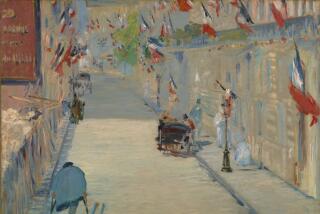The worst of times can make for the best of arts
- Share via
Virginia Woolf is often depicted as a dreamy, effete snob, agonizing all day over a single adjective while sipping tea -- but her tough-minded view of art would make her right at home with the shot-and-a-beer crowd. To create art, she knew, you need more than inspiration. More than drive. More than talent.
You need cash. Lots of it. Cash for things such as food and fuel, brushes and paint, shelter and shoes. “Money and a room of one’s own” was how Woolf phrased it in a 1928 lecture series that later became a classic book and foundational text of feminism.
The harsh practicality of her words, though, goes for male as well as female creators, and is especially relevant as the world economy circles the drain. With credit markets drying up faster than a Jackson Pollock canvas, with the international economic picture as murky and incomprehensible as a passage from “Finnegans Wake,” the question arises: Can bad times bring good art?
Judging from the last economic catastrophe that shook the nation to its core, the Great Depression that began in 1929 and lingered through the 1930s, the answer is “Yes.”
While it was a time of hardship and suffering on a massive scale, the Great Depression also was the crucible for many exquisite works of American art, including masterful novels, incomparable documentary photographs, stimulating architecture, sprightly music, provocative paintings and sculpture -- works that are still read and studied and appreciated today, some three-quarters of a century after their creation. It was a time of anxiety and dread, but also a time of vision and innovation.
The 1930s would see the rise of big bands and, at the movies, the Marx Brothers. In the same decade, plays such as Thornton Wilder’s “Our Town” (1938) appeared.
“The dramatic upheaval of life in the ‘30s opened up new areas of subject matter to young writers,” notes William Solomon, author of “Literature, Amusement, and Technology in the Great Depression” and an English professor at the University at Buffalo.
The federal government, rocked back on its heels by the plight of beleaguered citizens, nearly a third of whom were unemployed, realized that art still had a crucial role to play. In 1935, the Works Progress Administration, later known as the Works Projects Administration, was created, featuring separate divisions for artists, writers, musicians and theatrical performers. The Treasury Department commissioned murals to adorn post offices. The Farm Security Administration’s documentary project employed photographers and writers -- among them an obscure young woman from Mississippi named Eudora Welty -- to record the lives of ordinary people caught up in an extraordinarily bleak time. Other alumni from that project included Gordon Parks, Walker Evans and Dorothea Lange.
Posters created by WPA artists to bolster community spirit and encourage civic activity (“Help Your Neighborhood By Keeping Your Premises Clean”) were themselves bold works of art, as a forthcoming book demonstrates. “Posters for the People: Art of the WPA” includes some 500 lavish, richly hued posters.
Thus, while the consumers of art -- those who buy books and movie tickets, those who visit museums -- might have been hard-pressed to come up with the extra money and leisure time to patronize their favorite artists and arts organizations, many artists still were able to keep working. And their work would significantly transform the world’s conception of what constitutes appropriate subjects for art.
“One of the most remarkable aspects of this period was the impulse to reconsider the social functions of art,” Solomon declares. Such an impulse reflected a desire “to help represent or disclose the conditions of existence endured by Americans across the social or economic spectrum. Movies and books and music and photography and painting can contribute to the forging of collective bonds, and in the process maybe help alleviate suffering.”
More to Read
The biggest entertainment stories
Get our big stories about Hollywood, film, television, music, arts, culture and more right in your inbox as soon as they publish.
You may occasionally receive promotional content from the Los Angeles Times.










